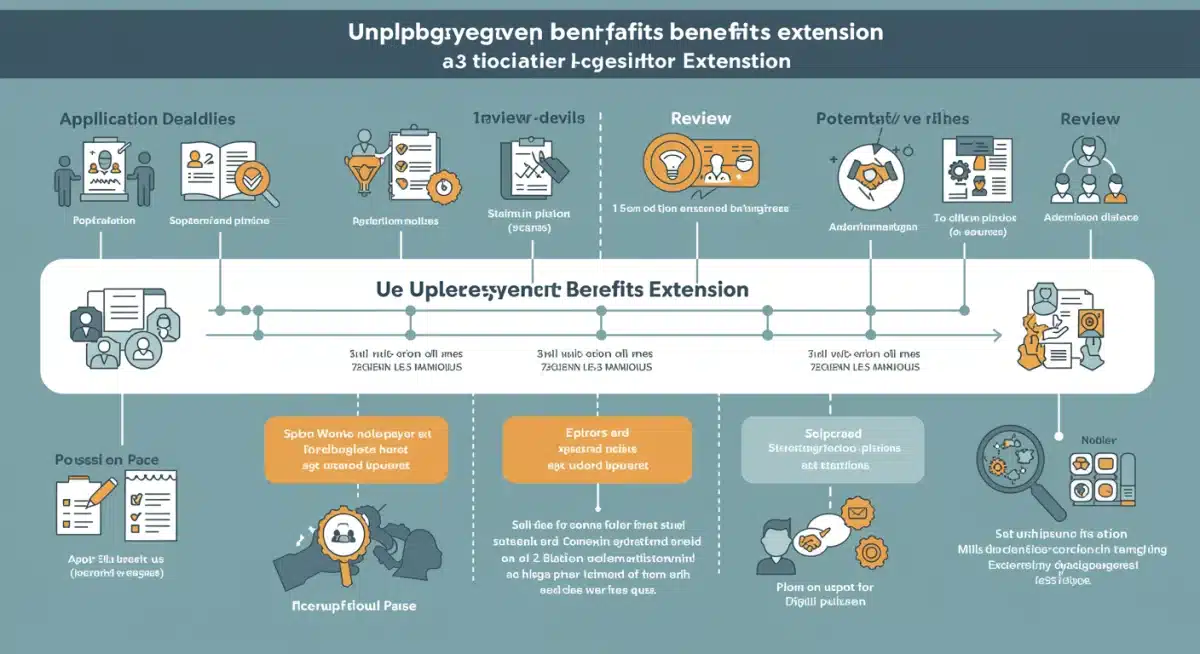Maximize Unemployment Benefits: Extend Support by 3 Months in 2025

Maximizing unemployment benefits involves understanding state-specific programs, proactive application strategies, and leveraging available extensions to potentially extend financial support for up to three additional months in 2025, crucial for maintaining economic stability during job transitions.
Navigating unemployment can be a challenging period, but understanding how to maximize unemployment benefits is crucial for maintaining financial stability. As we look towards 2025, proactive strategies and insider knowledge can help you extend your support by up to three months, making a significant difference during your job search.
Understanding the Basics of Unemployment Benefits in 2025
Before diving into extension strategies, it’s essential to have a solid grasp of how unemployment benefits generally operate. These benefits are a lifeline for many, providing temporary financial assistance to eligible workers who have lost their jobs through no fault of their own. Eligibility criteria, benefit amounts, and duration can vary significantly by state, making local knowledge indispensable.
In 2025, while federal programs might not be as widespread as during economic crises, states continue to manage their own unemployment insurance (UI) systems. These systems are typically funded by taxes on employers, ensuring that a safety net is available when needed. Understanding your state’s specific rules is the first step toward effective benefit management.
Eligibility Requirements Across States
Each state sets its own unique criteria for unemployment eligibility. Generally, you must meet certain conditions related to your past earnings and the reason for your job separation. It’s not enough to simply be unemployed; your unemployment must be involuntary, meaning you didn’t quit without good cause or were not fired for misconduct.
- Wage Requirements: Most states require you to have earned a certain amount of wages during a ‘base period’ (usually the first four of the last five completed calendar quarters before you filed your claim).
- Reason for Separation: You must be unemployed through no fault of your own. This typically excludes those who voluntarily quit without good cause or were terminated for serious misconduct.
- Availability for Work: You must be able, available, and actively seeking work. This often means registering with your state’s employment services and documenting your job search efforts.
Calculating Your Weekly Benefit Amount
Your weekly benefit amount (WBA) is also determined by state law and is usually a fraction of your past earnings during your base period. While there are maximum and minimum benefit amounts, understanding how your WBA is calculated can help you plan your finances more effectively.
For instance, some states use a formula based on your highest-earning quarter, while others consider your total earnings over the base period. It’s crucial to review your state’s specific methodology to get an accurate estimate of what you can expect to receive. This clarity helps in budgeting and assessing your financial needs during unemployment.
In essence, a thorough understanding of your state’s unemployment insurance system is fundamental. This includes meticulously checking eligibility requirements, familiarizing yourself with wage calculation methods, and proactively gathering all necessary documentation. This foundational knowledge will empower you to navigate the application process smoothly and prepare for potential extensions.
Proactive Application Strategies for Maximum Initial Approval
Securing your initial unemployment benefits approval hinges on a meticulous and timely application process. Many individuals overlook critical details that can either delay or even deny their claims. Being proactive and precise from the outset is not just about getting approved; it’s about setting the stage for potential extensions down the line.
The first step is always to file your claim as soon as you become unemployed. Delays can result in lost benefits, as most states do not backdate claims beyond a certain point. Gather all necessary documentation, such as your employment history, wage information, and reasons for separation, before you begin the online application.
Gathering Essential Documentation
The success of your application often depends on the completeness and accuracy of your submitted documents. Preparing these in advance can significantly streamline the process and reduce the likelihood of requests for additional information, which can cause delays.
- Social Security Number: Your SSN is fundamental for identification and wage verification.
- Driver’s License or State ID: Proof of identity and residency.
- Employment History: Names, addresses, and dates of employment for all employers in the last 18 months, including reasons for separation.
- Wage Information: Pay stubs, W-2 forms, or other records showing your earnings during the base period.
- Union Membership Information: If applicable.
- Alien Registration Number (if not a U.S. citizen): For non-citizens authorized to work in the U.S.
Accurate and Timely Filing
Accuracy is paramount when filling out your application. Any discrepancies or missing information can trigger a review, extending the time it takes to receive your benefits. Double-check every field, ensuring that dates, employer names, and personal details are correct. If you are unsure about a question, it’s better to contact your state’s unemployment office for clarification rather than guessing.
Furthermore, pay close attention to deadlines. Weekly or bi-weekly certifications must be submitted on time to continue receiving benefits. Missing these can lead to temporary benefit suspension or even the closure of your claim. Being diligent in your reporting is a non-negotiable aspect of maintaining your benefits.
By adopting a proactive approach to your initial application, you not only expedite the approval process but also build a strong foundation for any future need to extend your benefits. Precision, completeness, and timeliness are your greatest allies in securing and maintaining this vital financial support.
Leveraging State-Specific Extension Programs in 2025
While federal unemployment extensions may be less common in 2025 compared to previous years, many states offer their own programs to extend benefits beyond the standard duration. These state-specific programs are often less publicized but can be invaluable for individuals who have exhausted their initial benefits and are still actively seeking employment.
Understanding these programs requires diligent research into your state’s Department of Labor or equivalent agency website. Each state has unique criteria and application processes for these extensions, which are typically tied to local economic conditions or specific legislative initiatives.
Emergency Unemployment Compensation (EUC) and Extended Benefits (EB)
Historically, federal programs like Emergency Unemployment Compensation (EUC) and Extended Benefits (EB) have provided additional weeks of unemployment during periods of high unemployment. While federal EUC might not be active, the federal-state Extended Benefits (EB) program could still be triggered in states experiencing severe economic downturns.
- Extended Benefits (EB): This program is co-funded by federal and state governments and provides up to an additional 13 or 20 weeks of benefits. It is activated when a state’s insured unemployment rate reaches a certain threshold. It’s crucial to monitor your state’s economic indicators and announcements from your state’s unemployment agency to know if EB is in effect.
- State-Funded Extensions: Some states may implement their own temporary or permanent extension programs independent of federal triggers. These are often designed to address specific needs within the state’s workforce or economy.
Work-Share Programs and Training Opportunities
Beyond traditional benefit extensions, some states offer alternative programs that can effectively lengthen your support period or enhance your reemployment prospects. Work-share programs, for example, allow employers to reduce employee hours instead of laying them off completely, with employees receiving partial unemployment benefits to compensate for lost wages.
Furthermore, many states provide programs that allow you to continue receiving unemployment benefits while participating in approved training or educational programs. This is an excellent way to use your time constructively, acquire new skills, and remain eligible for benefits. These programs typically waive the ‘actively seeking work’ requirement, provided you are fully engaged in the approved training.
To fully leverage these state-specific options, it is imperative to directly contact your state’s unemployment office or visit their official website. Information can change rapidly, and personalized advice is often the most accurate. Proactive engagement with these resources can significantly impact your ability to extend financial support.
Documentation and Appeals: Securing Your Extended Benefits
Even with a strong understanding of state programs, the process of securing extended benefits often involves meticulous documentation and, at times, navigating an appeals process. The key to success lies in being prepared, organized, and persistent. Without proper records, even legitimate claims can face delays or denials.
Maintaining a detailed log of your job search efforts, communications with the unemployment office, and any related documents is critical. This organized approach serves as your evidence should any questions or disputes arise regarding your continued eligibility.
Maintaining Detailed Job Search Records
Most states require recipients of unemployment benefits to actively search for work and document their efforts. For extended benefits, this requirement often becomes even more stringent. Keeping comprehensive records is not just a formality; it’s a necessary step to prove your ongoing eligibility.
- Dates of Contact: Record the exact date you applied for a job or contacted an employer.
- Company Information: Note the name of the company, its address, and contact person (if known).
- Job Title and Description: Keep a record of the specific job you applied for.
- Method of Contact: Specify how you applied (e.g., online portal, email, in-person).
- Application Status: Track any responses or interviews you received.
Navigating the Appeals Process
Despite your best efforts, your application for extended benefits might be denied, or your existing benefits could be challenged. In such cases, understanding and utilizing the appeals process is vital. You have a right to appeal any decision you believe is incorrect.
The appeals process typically begins with filing a written appeal within a specified timeframe (often 10-30 days from the date of the denial notice). This usually leads to a hearing, either in person or via phone, where you can present your case and evidence. Having your detailed job search records and any other relevant documentation will be invaluable during this stage.
Preparing for an appeal involves gathering all supporting documents, understanding the specific reason for your denial, and clearly articulating why you believe the decision should be overturned. Seeking advice from legal aid services or unemployment advocates can also be beneficial in complex cases. Remember, persistence and a well-documented case significantly improve your chances of a successful appeal.
Strategic Job Search During Benefit Period
While maximizing unemployment benefits provides essential financial relief, the ultimate goal remains reemployment. A strategic job search during your benefit period is not just a requirement for eligibility; it’s an opportunity to leverage your time effectively and secure your next role efficiently. Integrating your job search with your benefit management is a smart approach.
Focusing on quality applications over quantity, networking proactively, and utilizing state employment resources can significantly shorten your unemployment duration. This approach ensures you’re not just receiving benefits, but actively working towards financial independence.
Optimizing Your Resume and Online Presence
Your resume and professional online presence (e.g., LinkedIn profile) are your primary marketing tools. Ensure they are up-to-date, tailored to the jobs you’re applying for, and highlight your most relevant skills and achievements. Many states offer free resume review services through their workforce development agencies.
- Tailor Your Resume: Customize your resume for each application to match keywords and requirements in the job description.
- Update LinkedIn: Ensure your LinkedIn profile reflects your current job search status, highlights your skills, and includes a professional photo.
- Portfolio (if applicable): For creative or technical roles, a strong online portfolio can showcase your work effectively.
Networking and Skill Development
Networking remains one of the most effective ways to find new employment. Attend industry events, join professional organizations, and connect with former colleagues or mentors. Many jobs are filled through referrals, so expanding your professional circle is invaluable.
Consider using your time to acquire new skills or certifications that enhance your marketability. Many online platforms offer free or affordable courses, and some state unemployment programs may even cover the cost of approved training. This not only boosts your resume but also demonstrates your commitment to professional growth, making you a more attractive candidate.
By strategically approaching your job search, you transform the period of receiving unemployment benefits into a productive phase of career development and active reemployment. This integrated strategy is key to transitioning back into the workforce swiftly and successfully.

Financial Planning While Receiving Benefits
Receiving unemployment benefits, even extended ones, typically means a reduction in your regular income. Effective financial planning during this period is crucial to stretch your funds, avoid debt, and maintain stability. This involves creating a realistic budget, exploring additional aid, and planning for the eventual cessation of benefits.
A proactive approach to managing your finances can alleviate stress and ensure that the extended benefits truly serve their purpose as a bridge to your next employment opportunity. Without careful planning, even an extended period of benefits can quickly prove insufficient.
Creating a Realistic Budget
The first step in financial planning is to create a detailed budget that reflects your reduced income. Prioritize essential expenses such as housing, food, utilities, and healthcare. Identify areas where you can cut back, distinguishing between needs and wants.
- Track Spending: Use budgeting apps or spreadsheets to monitor where your money is going.
- Cut Discretionary Spending: Temporarily reduce expenses like dining out, entertainment, and non-essential subscriptions.
- Emergency Fund: If you have an emergency fund, use it judiciously to cover critical gaps, but avoid depleting it entirely if possible.
Exploring Additional Financial Assistance
Unemployment benefits are just one piece of the financial safety net. Many other programs and resources can provide additional support during your job search. Explore options such as SNAP (food stamps), Medicaid for healthcare, and local housing assistance programs.
Community organizations and non-profits often offer assistance with utilities, food banks, and other essential needs. Don’t hesitate to reach out to these resources; they are designed to help individuals and families facing temporary financial hardship. Many states also have programs specifically for low-income individuals that you might now qualify for.
By diligently managing your budget and exploring all available avenues for financial assistance, you can maximize the impact of your unemployment benefits and better navigate the challenging period of joblessness. This comprehensive approach to financial well-being is essential for long-term stability.
Future Outlook: Economic Trends and Policy Changes in 2025
Looking ahead to 2025, the landscape of unemployment benefits and job market dynamics will continue to evolve. Staying informed about economic trends and potential policy changes is vital for anyone relying on or potentially needing unemployment support. These shifts can influence the availability of extensions, eligibility criteria, and the overall job recovery environment.
Economic forecasts suggest a cautious optimism, but regional disparities will likely persist. Understanding these broader contexts can help you anticipate changes and adjust your strategies accordingly, ensuring you remain proactive in your job search and benefit management.
Economic Indicators to Monitor
Key economic indicators can provide insights into the likelihood of federal or state-level benefit extensions. Monitoring the national and state unemployment rates, GDP growth, and inflation can give you an idea of the economic health and potential for policy interventions.
- Unemployment Rate: A consistently high unemployment rate in your state might trigger Extended Benefits (EB) or prompt state-specific legislative action.
- Job Growth Reports: Positive job growth indicates a stronger market, potentially shortening your job search. Conversely, stagnant growth might signal a longer period of unemployment.
- Inflation: Rising inflation can erode the purchasing power of your unemployment benefits, making careful budgeting even more critical.
Potential Policy Shifts and Advocacy
Unemployment benefit policies are subject to legislative changes at both federal and state levels. Advocacy groups and news outlets often track proposed bills and policy discussions that could impact benefit duration, eligibility, or amounts. Staying abreast of these developments allows you to anticipate changes and even participate in advocacy efforts if you feel strongly about certain policies.
For instance, there might be discussions around modernizing UI systems, enhancing training programs tied to benefits, or adjusting benefit levels to better reflect the cost of living. Engaging with these conversations, even as an informed citizen, can empower you to understand the broader context of your benefits.
By keeping an eye on economic trends and policy discussions, you can better prepare for any changes that might affect your unemployment benefits. This forward-looking perspective is an essential component of maximizing your support and ensuring a smoother transition back into the workforce in 2025.
| Key Strategy | Brief Description |
|---|---|
| Proactive Application | File promptly and accurately, gathering all necessary documents to avoid delays. |
| State Extension Programs | Research and apply for state-specific extended benefits or work-share programs. |
| Detailed Documentation | Maintain thorough records of job search efforts and communications for appeals. |
| Strategic Job Search | Optimize your resume, network, and use state resources to find new employment. |
Frequently Asked Questions About Unemployment Benefits
To determine if your state offers extended unemployment benefits, visit your state’s Department of Labor or Unemployment Insurance agency website. Look for sections on ‘Extended Benefits’ or ‘Additional Assistance.’ You can also contact their customer service line for direct information, as programs and eligibility criteria can change.
Eligibility for extensions usually requires you to have exhausted your regular benefits, remain able and available for work, and actively seek employment. Some programs may also require a certain level of unemployment in your state or participation in approved training programs. Specifics vary by state and program.
Yes, many states have programs that allow you to receive unemployment benefits while participating in approved training or educational courses. These programs often waive the traditional ‘actively seeking work’ requirement, provided the training is designed to enhance your reemployment prospects. Check with your state’s UI office for approved programs.
If your application for extended benefits is denied, you have the right to appeal the decision. Carefully review the denial notice for the reason and instructions on how to file an appeal. Gather all relevant documentation, such as job search logs and correspondence, to support your case during the appeals process.
To manage your finances effectively, create a detailed budget focusing on essential expenses and identifying areas to cut back. Explore additional assistance programs like SNAP or Medicaid. Consider community resources for help with utilities or food. Proactive financial planning is key to stretching your benefits.
Conclusion
Maximizing unemployment benefits in 2025 requires a combination of timely action, diligent research into state-specific programs, meticulous documentation, and strategic financial planning. By understanding your state’s eligibility criteria, proactively applying for initial and extended benefits, and maintaining detailed records, you can potentially extend your financial support by up to three crucial months. This period can be invaluable for securing new employment, acquiring new skills, and maintaining financial stability during a challenging transition. Staying informed about economic trends and policy changes will further empower you to navigate the unemployment landscape effectively, ensuring you leverage every available resource to your advantage.





